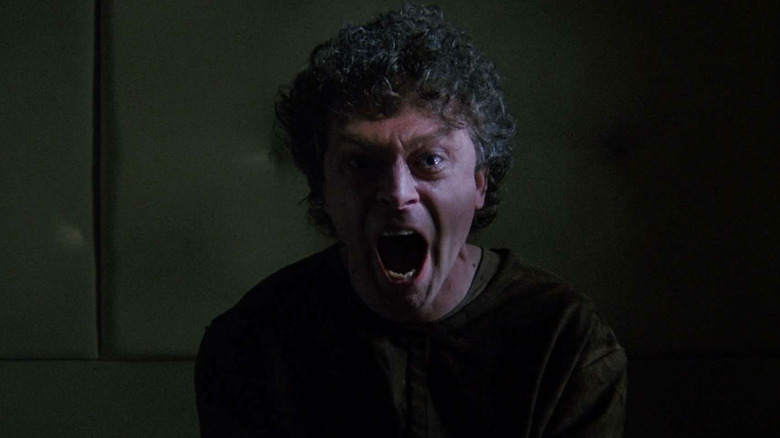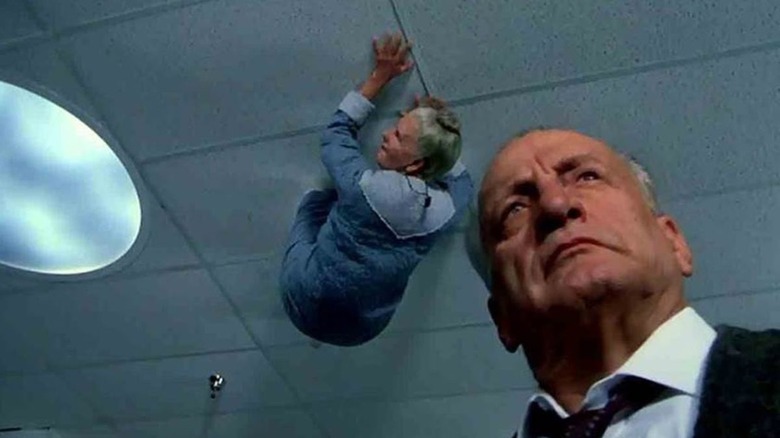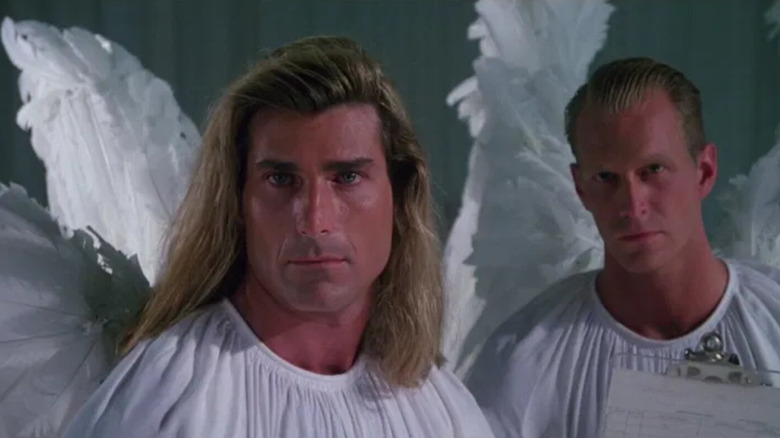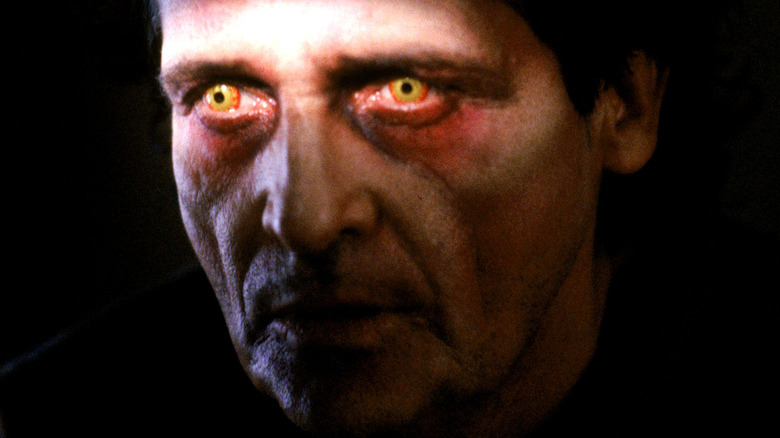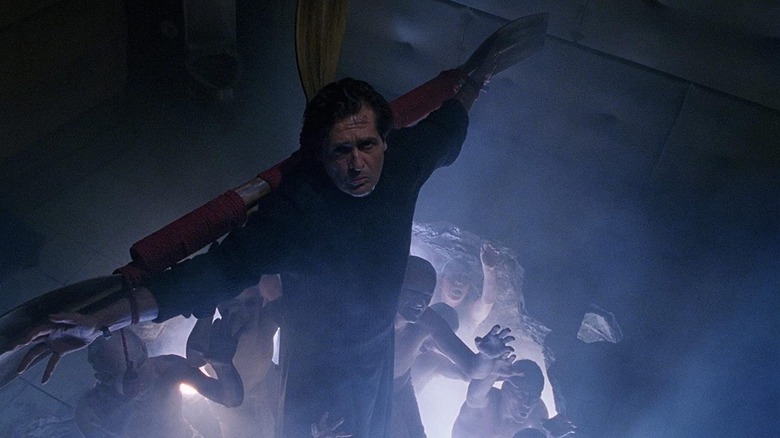The Exorcist III Ending Explained: Killing As An Act Of Love
With a string of idiosyncratic filmmakers, studio interference, and more 180-degree turns than Linda Blair's head, "The Exorcist" must be one of the strangest franchises to ever come out of Hollywood. That said, its flaws are also a boon — the films are far more interesting than the usual cookie-cutter horror sequels, with each entry feeling like a personal statement from its director, for better or worse. Well, usually for the worse.
Case in point: 1990's "The Exorcist III." After the goofy metaphysics of John Boorman's widely derided "Exorcist II: The Heretic," "The Exorcist" writer and author William Peter Blatty pitched a story called "Legion" for another sequel that would ignore the events of Boorman's film. Warner Bros. was keen, but after "The Exorcist" director William Friedkin left due to creative differences, the project ended up languishing in development hell. Blatty decided to turn "Legion" into a novel — and it became a best-seller.
Owing to that success, Blatty adapted the book into a screenplay, which was snapped up by Morgan Creek Productions. While the writer initially offered John Carpenter the directing gig, that partnership fell through as they didn't see eye to eye on the ending. And oh, Carpenter felt that Blatty himself wanted to direct this one. The "Exorcist" writer got the chance to step up as writer and director but the studio demanded for it to be titled "The Exorcist III" as they wanted to keep the brand awareness going. Despite the fact that the screenplay didn't feature any actual exorcisms. But the executives had a few ideas about that, too.
The final result is a fascinating occult murder mystery that captures the brooding malevolence of Friedkin's first film and massively improved on the second entry — but is too talky and has a blatantly tacked-on exorcism scene at the end. With that, it's time to look at Blatty's original intentions and how the studio's forced changes turned it into something else.
So what happens in The Exorcist III again?
"The Exorcist III" opens 15 years after the events of the 1973 original. Movie-loving detective William Kinderman (George C. Scott) and his pal Father Dyer (Ed Flanders) are trying to cheer each other up on the death anniversary of Father Karras, their mutual friend who perished falling down a steep flight of steps after the exorcism at the end of the first film.
Meanwhile, something infernal is prowling the Georgetown neighborhood once more. An evil force invades a church, a priest is killed in his own confession box, and a young black man is murdered in a horribly sacrilegious and racist manner. But fingerprints found at both crime scenes do not match, indicating that more than one person is behind the murders. Kinderman realizes this fits the modus operandi of James Venamun (Brad Dourif), aka the Gemini Killer, who was executed on the night of Karras's death.
After Father Dyer is murdered in a grisly fashion at the hospital while he's there for a check-up, Kinderman's inquiries lead him to Patient X (Jason Miller), a man in a psychiatric ward who was picked up 15 years earlier, wandering the streets and suffering with amnesia. The detective suspects the Gemini Killer is somehow behind the fresh spate of murders despite being dead, and he is further shocked to discover that the mysterious patient is the spitting image of Father Karras.
On top of all that, Patient X knows far more about past and present killings than seems possible — after all, the press was fed false information to weed out crackpots claiming responsibility. As the murders mount up in "The Exorcist III," Kinderman must crack the case before the killer strikes again.
Studio demands and other problems
For the first hour or so, "The Exorcist III" is a masterful slow burn from William Peter Blatty. It reintroduces us to Detective Kinderman and Father Dyer, two side characters who provided the original film with an unexpectedly upbeat note of friendship at its conclusion. Much of the pleasure of the opening act is the grumpy-old-man buddy comedy between the two, which gives the movie plenty of warmth and humor. Blatty uses this as a counterweight, against a foreboding atmosphere and some bizarre, unsettling imagery. An effigy of Christ opens its eyes in horror, while a campy dream sequence in "Heaven Station" features some unlikely cameos — Samuel L. Jackson, Fabio Lanzoni, and Patrick Ewing. It all builds steadily to a powerful two-hander between Kinderman and Father Karras/James Venamun, and one of the greatest jump scares I've ever seen.
But things get a little confusing during the lengthy confrontation between Kinderman and Patient X. In the original version of the film — a Director's Cut was released in 2016 — the role constantly flips between Jason Miller and Brad Dourif, making it unclear who or what the detective is actually seeing before him. I could have totally accepted Dourif as the likeness of Father Karras, just as I didn't question George C. Scott and Ed Flanders taking up the roles of Kinderman and Father Dyer. Throwing Miller into the mix as well just frazzled my brain, and not in a good way.
Except that is a minor problem compared to the ending of "The Exorcist III." Four months after the film wrapped, the studio insisted Blatty shoot a new effects-heavy conclusion involving an exorcism. Nicol Williamson was parachuted in to play Father Morning, a priest who seems to rock up out of nowhere to perform the rite. Though the scene works more or less, it feels completely at odds with the tone of the rest of the movie.
Who exactly is Patient X in The Exorcist III?
In the Director's Cut of "The Exorcist III," Lieutenant Kinderman has Father Karras exhumed and discovers that somebody else was buried in his place. We are later told the story of Brother Fain, an elderly priest who was the last person to see Karras's body before his funeral. Fain went missing afterward, which his superiors dismissed as his returning home to die after suffering two heart attacks. An autopsy reveals that he died after a third and there is every indication that he was scared to death.
During a lengthy monologue, Patient X tells us how it all played out. "The Master" was furious about Father Karras exorcizing the demon Pazuzu from Regan MacNeil (Linda Blair) at the end of the first movie. As revenge, he hit Karras right where it would hurt the most: his soul. He helped the Gemini Killer/James Venamun — freshly executed and floating around as a spirit — gain access to the priest's body as he lay dying at the bottom of the steps. The Killer then climbed out of his coffin in his new body, frightened poor old Brother Fain to death, and put Fain's body underground instead of Karras's.
But as Karras was severely brain damaged owing to the fall down the steps, Patient X was nearly catatonic when he was found wandering the streets on the night of Karras and the Venamun's deaths. It took 15 years to restore Karras to a functioning body and mind, ready to resume the killings. It's a vile punishment for Karras, with his soul trapped in his old body with Venamun and his demon friends, all while he's forced to watch the Gemini Killer commit further evil acts.
Original vs. Director's Cut
In both versions of "The Exorcist III," Detective Kinderman deduces that the Gemini Killer is body-hopping to commit more murders. After a little misdirection involving a cute kid, Kinderman realizes that one of the Killer's "old friends" from the ward is on her way to murder his family. He rushes home to thwart the attempt, which is where the two cuts diverge.
In the original theatrical version, the Gemini Killer's attack on Kinderman and his family is cut short when Father Morning intervenes with an exorcism, getting badly mutilated in the process. Kinderman returns to the hospital and Patient X turns his powers on the detective, who is only saved when Karras manages to wrestle control of his body. Kinderman shoots him dead, freeing Karras from his torment, and "The Exorcist III" ends abruptly with Kinderman standing by the priest's grave.
The Director's Cut, pieced together from VHS dailies from the film's production, gives us a better idea of William Peter Blatty's original vision. The VHS scenes are poor quality, but they contain extra exposition to help us figure out what is going on. To clarify matters, Patient X is only played by Brad Dourif, making it more obvious that he is supposed to look just like Father Karras.
But the biggest change is reserved for the ending. The Gemini Killer's murderous scheme is halted when Karras fights back, saving his old friend Kinderman. The detective then returns to the hospital to put Karras out of his suffering — an act of love that spells the end for the detective too. Without the (forced) exorcism, it is likely that Kinderman is arrested for gunning down a patient in his cell. It's a bleaker ending, but a far more satisfying one.
